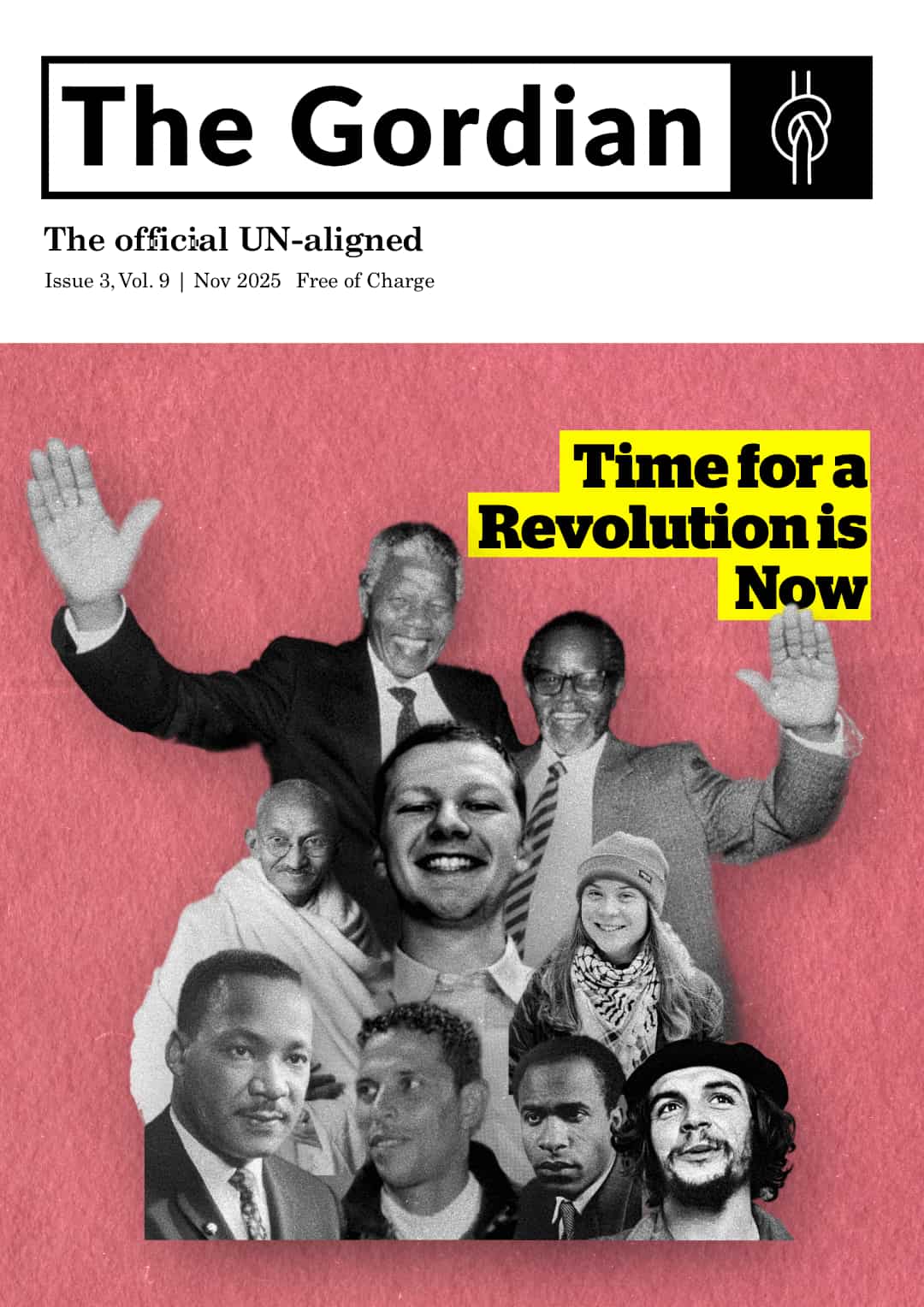"Just Let Them Eat Fudge..."
Plunging into the ocean of UN communiques is like drowning in an alphabet soup. Often, the words are noble, the causes honourable. Occasionally they even make a difference... and yet the members of this mighty club behave like undisciplined children who delight in doing just as they please. In this issue of The Gordian, following the re-election of the Secretary-General, Antonio Guterres, we will be discussing everything relating to his post and office. This issue contains more exclusive reports by, our literary editor, Alex Liberto, and other UN-aligned members, namely Jonna Lappalainen, Carla Pietrobattista and Aryan Yekrangi. The editors are Adrian Liberto and Ariana Yekrangi.
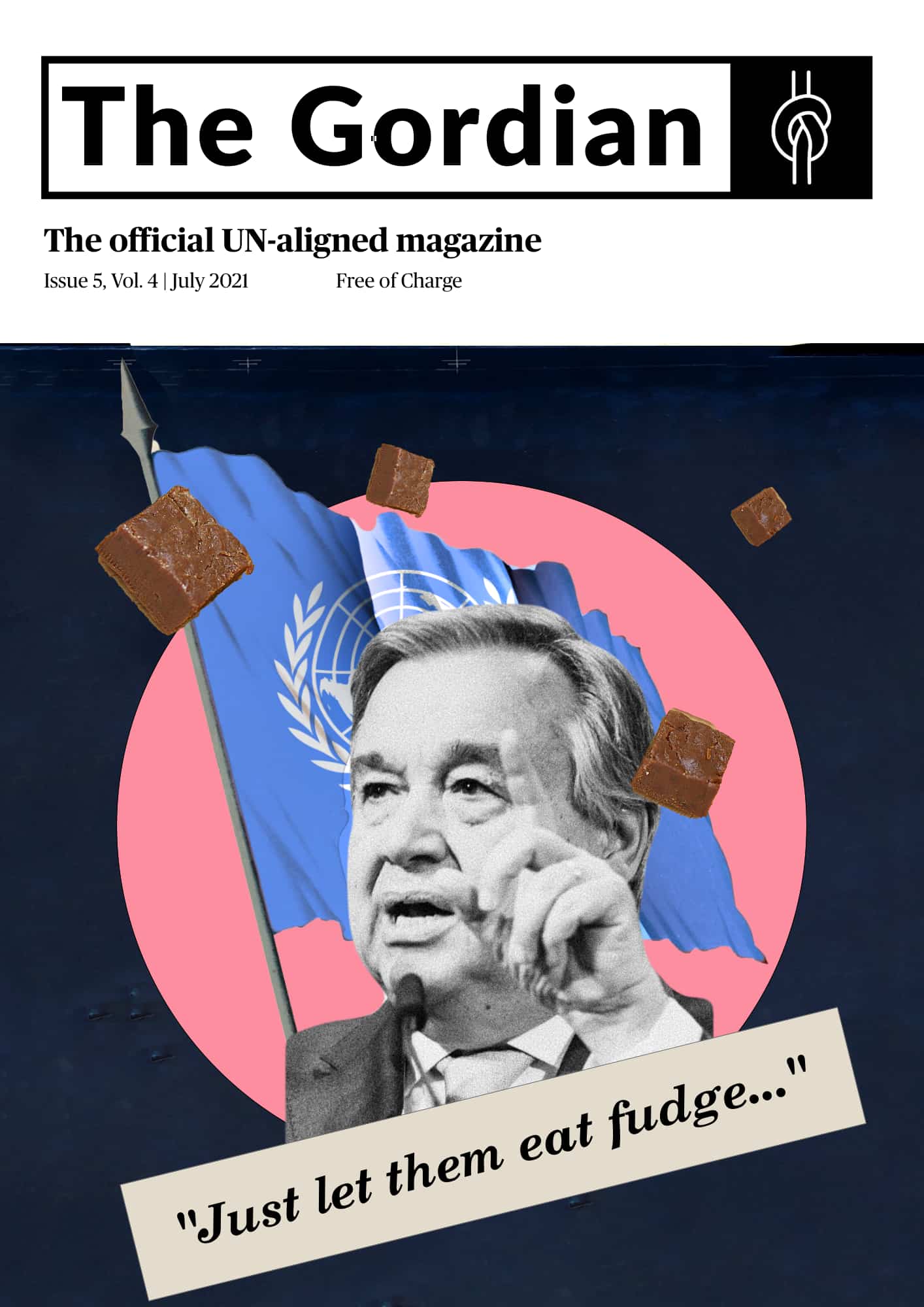
A fervid summer: Share your favourite books, TV shows & music with our international readers

Photo by CandiceP/Pixabay
More and more people are using their free time in summer to relax and enjoy a good book, movie, TV show or a piece of music.
UN-aligneders are from all across the world. We currently have members from over 24 countries, so we are certain that curating a list of your favorite entertainment will help inspire our international community.
Please fill out the form below and send us your suggestions; tell us also why enjoyed them and will publish your answers on The Gordian Magazine, UN-aligned’s monthly publication.
[elementor-template id=“21449”]
UN-aligned writing course renewed for September!

Join our free writing course and get your articles published by The Gordian Magazine, UN-aligned’s monthly publication. Photo from Facebook.
In the space of just five lessons, starting on the first of July, Adrian Liberto, author, journalist, a former professor at the American University of Rome and current editor-in-chief of the Gordian Magazine, will teach you how to overcome your weaknesses in writing.
António Guterres: The Power Under The Throne
By Adrian Liberto
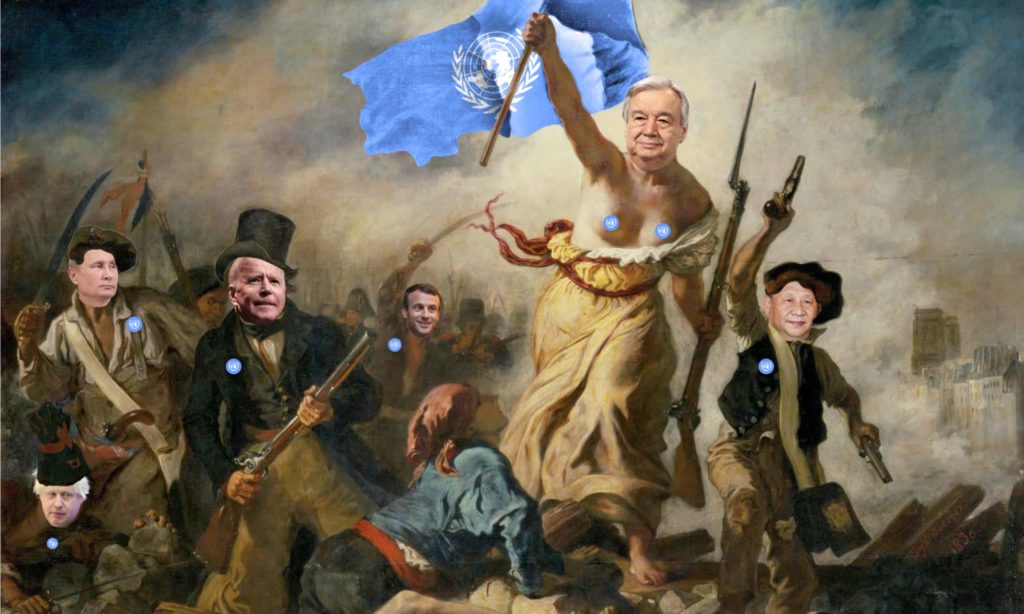
Antonio Guterres and the five permanent members of the UN Security Council. Graphic by the UN-aligned Design team.
The feeling I experience when plunging into the ocean of communiques from the United Nations is always the same: drowning in an alphabet soup. Often, the words are noble, the causes honourable. Occasionally they even make a difference. Report after report; document after document; resolution after resolution… and yet the members of this mighty club behave like undisciplined children who delight in doing just as they please. The world of politics rolls on like a combined harvester devoid of breaks, macerating anyone unfortunate enough to get in its way. They only serve to create one grim statistic after another.
The inevitable feeds off the preventable caught in the headlights of fake news, fake politics and all too real indifference. The United Nation should be above all that, but we have been content to settle for a toothless dinosaur whose greatest ambition is mere damage limitation. We deserve better. Well, we should. UN-aligneders do, because they have already made a statement: THIS IS NOT HOW I WANT TO BE REPRESENTED.
The Secretary General’s remit
So, leaving the metaphors behind, what does António Guterres’ election to a second term as UN Secretary General mean? All said and done, not very much. The Secretary General is more like an ambassador than an actual leader, except that an ambassador answers to one country, the Secretary General answers to 193!
“The Secretary-General is appointed by the General Assembly ‘upon the recommendation of the Security Council’. This means that any of the five permanent members can block a nomination by voting against it, as happened to Boutros Boutros-Ghali when the USA ‘vetoed’ his reselection in 1996. Consequently, it would be highly unlikely that a genuine reformist could be appointed to the post, as the candidate would have problems securing the favour of the five gatekeepers.
To date, the General Assembly has never failed to appoint the recommended candidate, who has always been male.”
Unravelling the United Nations - Adrian Liberto
Impartiality is one of the requirements for the post and this includes complete independence from all national governments. One of the main tasks of the Secretary General is bringing “to the attention of the Security Council” any matter that “may threaten the maintenance of international peace and security.” Whilst it would be totally inaccurate to describe the role as ceremonial, in practice there is little the Secretary General can do if opposed by any one of the five permanent members of the Security Council.
António Guterres has been quite outspoken at times, but those brave words are easily undermined. His blunt condemnation of abuses in Yemen, Syria and Burma, for instance, have had little chance of producing the desired changes because of the support the perpetrators have had form the US, Russia and China respectively. As a consequence, people just keep losing their human rights, their homes and their very lives.
Sticking one’s head out and losing it
One Secretary General, Dag Hammarskjöld, did try to take matters into his own hands by rolling up his sleeves and opting for direct action. His style probably felt threatening to all five permanent Security Council members and it certainly cost him his life, most likely at the hands of the CIA (US) and MI6 (UK), possibly with Belgian involvement. His plane was shot down while he was on his way to negotiate a cease-fire between UN forces and the Katangese troops under Moise Tshombe who were fighting for independence from the rest of the Congo, spurred on by Belgian mining interests. Despite evidence to the contrary, the US blamed the assassination on the USSR.
Whoever was responsible for his death, the message was unequivocal: stay put and don’t step on anyone’s toes. Hammarskjöld was only the second Secretary-General to hold the post. A warning shot may have triggered a defensive response that could have had profound implications for the future trajectory of the UN, so it seems as though to avoid any ambiguity the order was simple: ‘shoot to kill’. The ploy had the desired effect and successive UN Secretary Generals were careful not to rock the boat even when faced with atrocities of genocidal proportions.
Making the best of a bad job
As for Guterres, he does what he can. His first appointment as Secretary General in 2017 followed a glittering career which included being the socialist Prime Minister of Portugal from 1995 to 2002, serving as President of the Socialist International from 1999 to 2005 and his appointment as UN High Commissioner for Refugees from 2005 to 20015. Sadly, his track record on human rights has not always been exemplary. In 1995, for instance, referring to the WHO’s removal of homosexuality from the list of mental illnesses in 1990, Guterres claimed that he “did not like homosexuality” and that it was something that “bothered” him.
Nevertheless, his government introduced some bold reforms, such as the decriminalising of drug use and the legalisation of same-sex civil unions. During his first term as Secretary-General, he spoke out in support of various oppressed civilians, including those in Syria, Myanmar and Yemen, though he has been accused of not always going far enough, as in the case of the abuses against the Uyghurs.
In June, following the Security Council’s endorsement, Guterres, who was the only candidate, was voted in for the January 2022 – December 2026 term by the General Assembly. On June 18th he tweeted:
“I am deeply honoured and grateful for the trust placed in me to serve as the Secretary-General of the United Nations for a second term.”
Speaking to ambassadors, Guterres said:
“We are writing our own history with the choices we make right now. It can go either way: breakdown and perpetual crisis or breakthrough and prospect of a greener, safer and better future for all. There are reasons to be hopeful.”
Ultimately, apart from an investigation here and several “deeply concerned” type comments there, Guterres’s first tenure had little of note and it is unlikely that he will surprise us in his second. This is not, however, due to his lack of goodwill and integrity as it would be very difficult to achieve much more under the current circumstances.
Former President Trump showed us just how easy it was to withdraw funding from the UN, proving that it is no longer necessary to assassinate an individual when the whole organisation can so readily be brought to its knees.
As the saying goes: He who pays the piper calls the tune.
UN Secretaries-General: A Gallery Timeline
By Jonna Lappalainen
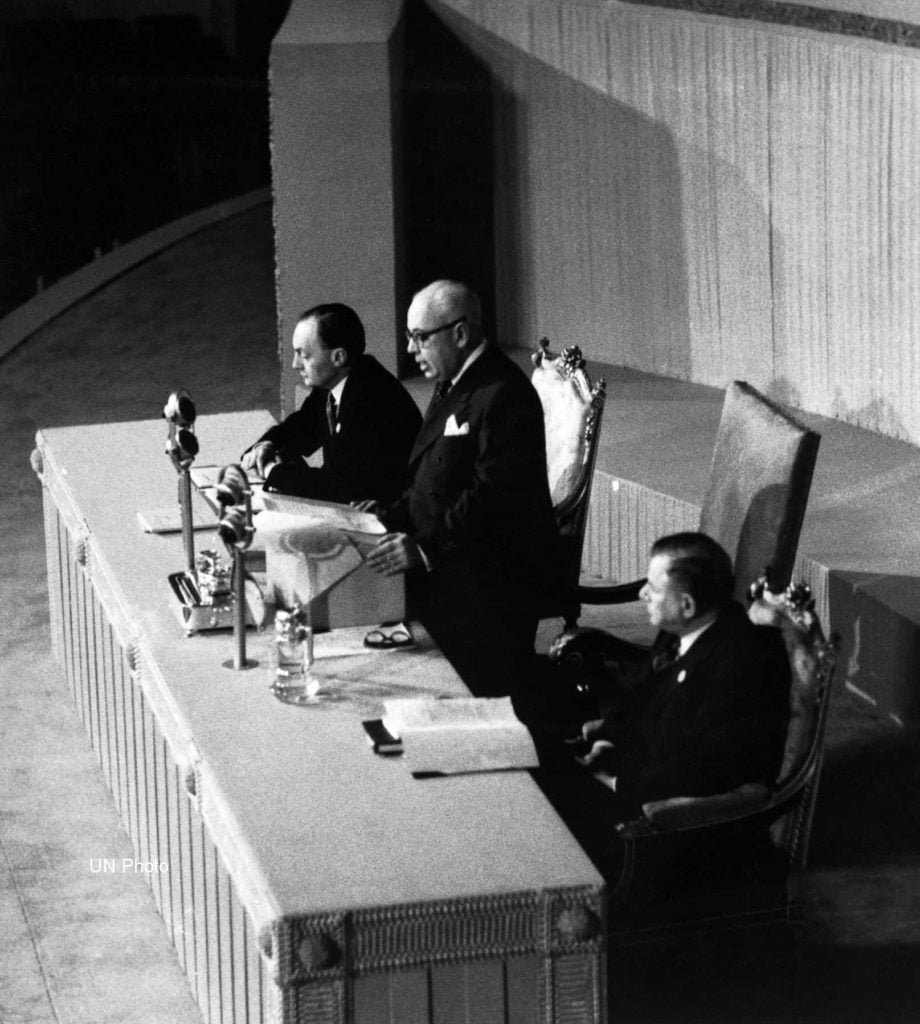
Gladwyn Jebb (on the right) attending the first session of the United Nations General Assembly in London on the 10th of January 1946. Photo by Marcel Bolomey / UN Photo
8 UN Secretariat Offices explained in 10 minutes
By Ariana Yekrangi

United Nations Headquarters in New York City, view from Roosevelt Island.
The Secretariat consists of the personnel of the United Nations, with the Secretary-General as its head. It is estimated that as of 2021, more than 35,000 people are employed by the United Nations. Currently, the Secretariat consists of about 30 departments and offices. In this article, we will take a look at some of the most interesting ones.
1. What is the purpose of the UN Secretariat?
This body of the UN is tasked with assisting and facilitating the functioning of the other principal organs. Some of its most important tasks are:
- Providing the necessary staff for all departments and offices,
- Administering the UN budget,
- Arranging the agendas,
- Preparing reports to enable discussion on agenda topics,
- Providing expert advice, and
- Supervising ongoing operations.
Apart from the Secretary-General’s office, the UN Secretariat is organised into various offices that reflect the functions and duties of the principal organs (like political affairs, disarmament…) and functional departments (like legal services, public information…).
A heads up before we start: The UN is pretty bad at choosing acronyms. Sometimes you are better off remembering the full name of the office. I shall leave the acronyms here nevertheless.
2. Executive Office of the Secretary-General (EOSG)
This is the main office of the Secretary-General. Chapter 15 of the UN Charter, describes the UN Secretary-General role as the “chief administrative officer” of the organisation, and thus tasked to carry out duties and mandates delegated to him by United Nations organs including Security Council, General Assembly, and the Economic and Social Council.
It would be highly unlikely that a genuine reformist could be appointed to the post
Article 97 in the same chapter however, makes it abundantly clear that the Secretary-General must be appointed “upon the recommendation of the Security Council” by the General Assembly, meaning that any of the 5 permanent members of the UN (US, UK, China, Russia and France) can block a nomination of the General Assembly by voting against it. Classic!
So if you have ever wondered why a particular Secretary-General’s stand on a certain topic was lamentable, it is because the Secretary-General would have had problems securing his re-election and the favour of the five gatekeepers.
The current office of the Secretary-General also includes:
- The Deputy-Secretary-General (DSG), who, amongst other things, is “responsible to assist the Secretary-General in managing the operations of the Secretariat”. This position was established in 1997 by Kofi Annan as an attempt to increase the efficiency and cohesiveness of the Executive Office of the Secretary-General.
- The special adviser on Climate Action, who is assigned to ensure the “delivery of the Secretary-General’s priorities on climate change”.
- The Assistant for Strategic Coordination, responsible for “ensuring coherence in the strategic analysis provided to the Secretary-General and conducts system-wide coordination”.
- The Senior Advisor on Policy.
- The Chief of Cabinet.
3. United Nations Office of Internal Oversight Services (OIOS)
The UN’s Office of Internal Oversight Services acts as the United Nations’ internal corruption watchdog. Internal audit, investigation, inspection, and assessment services are provided by the OIOS to assist the Secretary-General in fulfilling his supervisory responsibilities for both the organization’s resources and staff.
The OIOS was formed in 1994 at the request of the United States that the UN make efforts to reduce waste and corruption, however the effectiveness of this office has been questioned on numerous occasions.
In 2015, for example, Carman Lapointe, a Canadian who served as the head of the OIOS, was accused by Michael Stefanovic, director of the UN’s Investigations Division, of “collusion with senior officials to conduct a misguided leak investigation into a whistleblower who exposed the sexual exploitation of children by foreign troops in the Central African Republic (CAR).” Stefanovic later said Lapointe should be investigated for wrongdoing.
Although an inquiry from the UN and OIOS did name 41 peacekeepers in relation to alleged sexual abuse and exploitation, to this day, few peacekeepers have been prosecuted.
4. United Nations Office of Legal Affairs (OLA)
The United Nations Office of Legal Affairs (OLA) offers unified central legal services to UN headquarters and other UN institutions. OLA registers, publishes, and serves as a depository of international treaties in accordance with Article 102 of the UN Charter.
OLA also works towards strengthening, developing, and codifying international public and trade law, as well as those of the international legal system for the seas and oceans.
The Office of Legal Affairs also acts as the Organisation’s focal point for corporations between the United Nations and the International Criminal Court ICC. All United Nations entities can seek advice from OLA regarding matters of cooperation with any organ of the Court. All UN institutions can seek guidance from OLA in regards to cooperation with any organs of the Court.
5. United Nations Office for Disarmament Affairs (UNODA)
Established in 1998 during Kofi Annan’s incentive to reform the UN, the Office for Disarmament Affair seeks to promote nuclear disarmament and non-proliferation, as well as fostering preventive disarmament measures during conflicts, particularly those involving landmines and small weaponry.
UNODA also supports the implementation of practical disarmament measures after a conflict, such as disarming fighters and helping them to reintegrate back into the society.
In October 2020, an international treaty banning nuclear weapons was ratified by 50 countries in the General Assembly, permitting the historic text to enter reality. Although the ODA deserves credit for this, it should be noted that NONE, yes none, of the nuclear-weapon states has actually signed up to this agreement, making the treaty essentially worthless and symbolic.
The US was even reported to have written to treaty signatories saying the Trump administration believes they made “a strategic error” and urged them to “rescind their ratification”. Pathetic!
Nuclear-armed states have long argued that their arsenals intend to serve as a deterrent and that they are fully committed to the nuclear non-proliferation treaty.
The Office for Disarmament Affairs comprises of five branches:
- Conference on Disarmament Secretariat and Conference Support Branch: Based in Geneva, this branch provides organisational servicing to the Conference on Disarmament, a multilateral disarmament negotiating forum.
- Weapons of Mass Destruction Branch (WMD): Focusing on weapons of mass destruction like nuclear, chemical and biological weapons, this organ works closely with the International Atomic Energy Agency (IAEA), Organisation for the Prohibition of Chemical Weapons (OPSW) and Comprehensive Nuclear-Test-Ban Treaty Organisation CTBTO to promote the non-proliferation of WMD.
- Conventional Arms (including Practical Disarmament) Branch (CAB): Generally concentrates its work on smaller weapons that are not classified as WMD.
- The Information and Outreach Branch (IOB): Provides advisory services to states on disarmament measures
- Regional Disarmament Branch (RDB). Which acts as an information officer, updating content on the UNODA’s website and maintaining databases.
6. United Nations Office for the Coordination of Humanitarian Affairs (OCHA)
Created in 1991by the General Assembly, the OCHA is responsible for bringing humanitarian actors together for a coordinated response to emergencies and natural disasters.
You can learn more about OCHA and the services they offer by visiting their website.
7. United Nations Office of the High Representative for the Least Developed Countries, Landlocked Developing Countries and Small Island Developing States (OHRLLS)
What may seem to be a disastrous attempt at naming a UN Secretariat Office, is actually entrusted with the great responsibility of assisting 91 vulnerable Member States of the United Nations.
As the name implies these vulnerable states are categorised into three groups:
- 46 Least Developed Countries (LDCs): Consist of the world’s poorest and most vulnerable people.
- 32 Landlocked Developing Countries (LLDCs): Consist of nations who lack territorial access to the sea and due to their remoteness have significant distance from world markets.
- 38 Small Island Developing States (SIDS): A group of remote islands often suffering due to climate change.
8. United Nations Office for Outer Space Affairs (UNOOSA)
The overall objective of the UN Office for Foreign Space Affairs is to promote international cooperation and the peaceful use of outer space. The office also intends to govern the exploration and use of space for the benefit of all humanity by setting up a treaty of space law.
Who knows, maybe soon we will be able to appoint space ambassadors!
The development of a platform for space-based information systems for disaster management and creating the International Committee on Global Navigation Satellite Systems (ICG) are some other examples of their work. You can explore all the projects of UNOOSA by visiting their site.
I hope you enjoyed this piece. We will try our best to expand this piece to cover all 30 Departments and Offices of the UN. If you would like to help us with that, please contact us, we would love to hear from you.
Edward Mortimer was wrong that about the United Nations
By Ariana Yekrangi
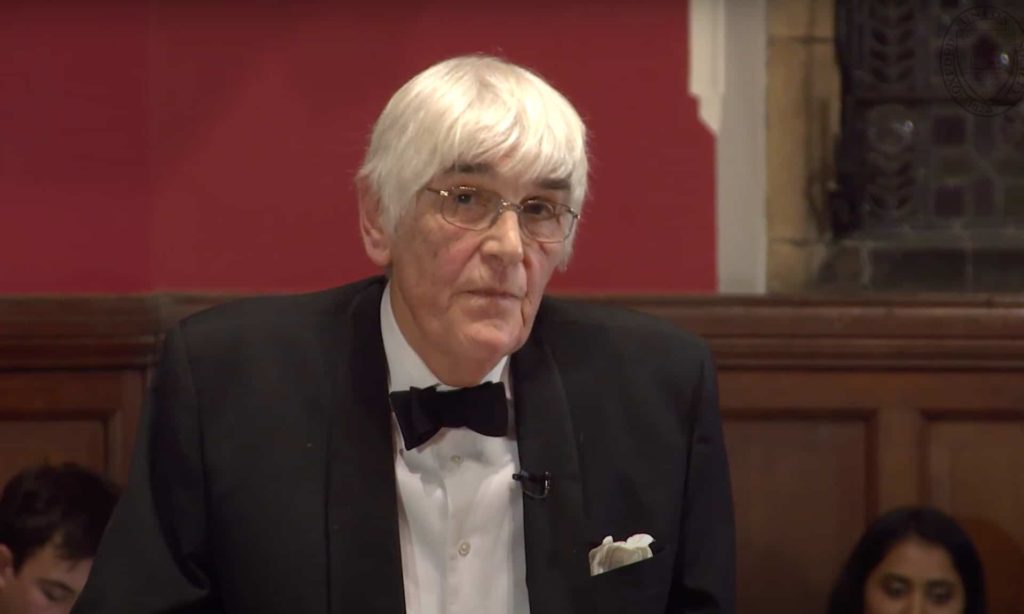
A screenshot from Edward Mortimer’s speech at the Oxford Union.
Last week Edward Mortimer, the chief speechwriter for Kofi Annan, passed away at the age of 77. He was described as “one of the lively minds surrounding the Secretary-General, given license to think and experiment at a time when the future of the United Nations was being written anew”. We wish his friends and family our deepest condolences.
Today, however, we would like to point your attention towards a passionate, but peculiar, speech he made to the Oxford Union in 2017 defending why the United Nations is not a failing institution.
Mr. Mortimer did acknowledge that the UN had its faults, but instead decided to debate why the UN was essential for the modern world. Standing at the Oxford Union’s dispatch box, he argued that the UN possessed a special and unique legitimacy because of its universal membership. Although he did acknowledge that this is an airy-fairy and abstract statement, he continued to deliver a curious and wacky speech.
1. The “there is a unique legitimacy about the UN” argument
To prove this so-called “international legitimacy”, Edward Mortimer tells a story about the Iraqi invasion in 2003. Following the Coalition Provisional Authority’s refusal to democratically hand over power to the sovereign government, Ayatollah Sistani, an influential Iraqi Shia cleric, asked for the assurance of the United Nations that the new government would be elected by the Iraqi people.
He continues by describing a meeting in the basement of the United Nations headquarters, which included Paul Bremer, Ahamd Chalabi and Abdul Aziz Al-Hakim, amongst other key figures in the Iraqi government, where the participants did everything, short of “getting down on their knees” to Kofi Annan, to convince him to send someone to reassure Sistani.
This he points out is “what legitimacy is about’’. Later, he claimed that there is no other organisation that can provide that.
Although Edward Mortimer may have a point when he refers to the profuse and diverse members of the UN, many of whom have floated pretty much all forms of decency, he leaves the listener with one giant question.
With the Security Council at its heart, isn’t the UN’s raison d’etre the maintenance of international peace and security? So how come, two of its permanent members, the UK and the US found themselves invading Iraq?
2. Let’s not pretend the Security Council is not part of the UN
When in March 2003 the US hawkishly declared that “diplomacy had failed” and that it would proceed with a “coalition of the willing” to rid Iraq of weapons of mass destruction it so desperately (and of course falsely) insisted it possessed, everyone in the UN was powerless.
This is the first hole inside Edward Mortimer’s argument. The Permanent members of the Security Council have been tasked with an extraordinary mission: to preserve international peace through upholding international law and regulations. But looking back at the UK/US coalition that led the destruction of Iraq, Afghanistan, Libya and, by proxy, Yemen, amongst many other places, the US and the UK seem less concerned with maintaining “International law”, but rather keen on upholding an attitude of “might makes right”. Adding China and Russia (two other permanent members of the UNSC) to this coalition of chaos takes this gangster “law,” rule on an international level.
Was 2.4 million Iraqi deaths worth it?
Many may argue that the Iraq invasion violated the UN Charter as well as UN Security Council Resolution 1441, others may insist that the war was perfectly justified as the law of war authorises the use of force in the case of “self-defence”. Many however seem to hail the invasion because it got rid of the Iraqi dictator Sadam Hossein. To all those subscribing to this thesis, however, I liked to ask one question: was 2.4 million Iraqi deaths worth it?
In the case of Iraq, the UN’s failure to fulfil the promise of promoting peace and security and protecting human rights offers a clear example of how ineffectual the organisation can be. The ICC, the ICJ, the Security Council, amongst other UN bodies, were all powerless to stand up and hold the US and the UK accountable for their war crimes.
Eventually, various UN agencies did what they could to help Iraq. In August 2003, for example, at the request of the Iraqi government, the United Nations Assistance Mission for Iraq (UNAMI) was formed. However, by now, all of this felt less like peace maintenance and more like cleaning after the US and the UK.
The demented logic Mortimer chooses to ignore…
You may be thinking that surely within a large organisation like the UN, there must be someone to turn to. Well, good and bad news: As outlined in Article 39 of the UN charter, there is someone that can rule on the legality of the war, but brace yourselves, it’s, surprise, surprise, the UN Security Council, a place paralysed by the uncontrolled vetoes of the very accused. This is precisely the kind of demented logic that Edward Mortimer chooses to ignore.
Needless to say that to this day, all five permanent members of the Security Council continue to get away with their self-interested agendas, without being subject to any sanctions or prosecution.
3. The “International law must not be breached” argument
Mr. Mortimer finishes his speech by saying that voting against the UN would issue a trump card for authoritarian rulers who are reluctant to accept the idea of international law. Again, taking a closer look at the Security Council’s resolution over Israel and Syria should make clear what countries hold themselves above international law.
Of course, it is likely that Mr. Mortimer speaks to those who think there is no place for the UN in today’s world. If this is indeed the case, he is absolutely right in insisting that the idea of the UN is quintessential to a unified world. However, not everyone who thinks the UN is a failing organisation does so with the intention of abolishing multilateralism and international law.
UN-aligned thinks the world of the United Nations’ goals and ambitions, we truly do. We believe that they are vital to promoting international law and human rights and effectively combat the climate catastrophe. We do not however think the current structure is fit for the challenges of the modern world. Read our manifesto to see where we stand.
Much like Edward Mortimer let us work towards a better United Nations, but this time, one that is founded on clearer ethical principles. Join UN-aligned to discuss and debate what this organisation could look like.
UN in Focus: The sluggish justice of the UN & UNESCO making a decision on Venice
By Adrian Liberto and Ariana Yekrangi

The slow pace of justice
UN judges have still not quite finished with the aftermath of the atrocities relating to the breakup of the former Yugoslavia almost 30 years ago. On June 30, they convicted former head of Serbia’s State Security Service, Jovica Stanisic, and his subordinate Franko “Frenki” Simatovic to 12 years in prison. The two men, now in their seventies, were initially acquitted in 2013, after having entered into court custody ten years earlier, but a retrial was ordered in 2015. If UN justice were any slower, it would probably have to be a post mortem affair involving psychopomps and psychostasis.
Venice on the brink
This month UNESCO is due to decide on whether to put the city of Venice on its list of World Heritage in Danger sites. The proposal, put forward a few weeks ago, will highlight the precarious status of the city, overwhelmed by tourism and vulnerable to climate change. The city and its lagoon were put on its list of World Heritage Sites in 1987. The list of endangered sites, created in 1972 “is designed to inform the international community of conditions which threaten the very characteristics for which a property was inscribed on the World Heritage List, and to encourage corrective action”. Currently 53 “properties” are on the World Heritage in Danger list.
Read other articles from this month’s UN in Focus:
- “Pay no heed to the hippie”: Filippo Grandi, UNHCR chief, ignored once again
- Guterres publishes report about the lack of progress of UNSC Resolution 2334
- Eradicate colonialism by 2030? Unlikely.
- Who is Jean Arnault and what can he do about the Afghan peace talks?
- France halts its joint military operations in Mali as the G7 pledge 870 million doses of vaccine to the world
- Who are the 5 new non-permanent members of the UNSC for the term of 2022-2023?
- Mladic revisited: An unremarkable news item, were it not for the absurdity of the process
Towards The Third Millennium: UK literature after The Second World War
By Alex Liberto
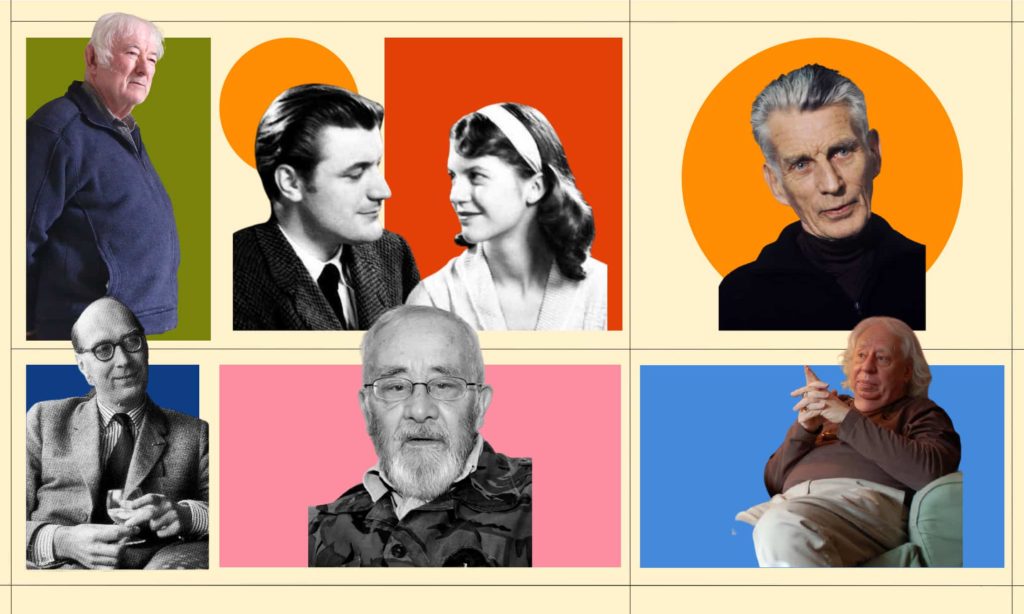
Photo by the UN-aligned design team.
The literature that was produced in Great Britain after the Second World War clearly portrayed man’s utter confusion and disorientation caused by those terrible years of violence and devastation. This sense of pessimistic bewilderment was characterised in literature by the absence of any one specific school of thought. Writers had closed in on themselves and tended to be more individual in their search for self-expression.
The 1950s and 1960s were very slow in creating any compact movements. The most revolutionary writers of this period were the writers labelled the Angry Young Men and the playwrights of the Theatre of the Absurd.
The Angry Young Men
The literary school called The Angry Young Men was formed by writers who were writing within different genres of literature. The term, taken from Leslie Paul’s work, Angry Young Men, described all those playwrights, poets and novelists who expressed their anger and sarcasm at the emerging social friction between classes.
The writers who best captured this sense of frustration were undoubtedly Kingsley Amis, Alan Sillitoe, John Braine and David Storey. The main themes of this school were cultural and political disillusionment; a feeling that culture had fallen to a level of degradation, becoming almost pseudo-culture.
One of the best works of this type was Lucky Jim, written in 1954 by Amis.
The Theatre of the Absurd
The playwrights of the Theatre of the Absurd managed to shift the focus from plot and structure, to surrealistic illusion and self-expression. The two giants in this field were Samuel Beckett and Harold Pinter.
Samuel Beckett is best known for his masterpiece Waiting for Godot (1952), a play that shocked the traditional critics who desperately searched for plot, characterisation, orchestrated dialogue or just a plain simple story, and found none. The play, on the contrary, was more of an incarnation of an idea, a spotlight on man’s loss of communicability and self-awareness.
Harold Pinter became famous for the Pinteresque style of dialogue which expressed the disharmony of society. He saw man as an object that simply existed. He echoed Beckett’s description of man as “a scrap of life surrounded by death, a something encircled by nothing.”
The Theatre of the Absurd illustrated chunks of dreams and nightmares, highlighting themes of loneliness, isolation and suffering in a world in which all values and ideals were lost.
The Movement and The Group
Post Second World War poetry was extensive and very versatile, ranging from movements, groups, individualists and traditionalists.
Dylan Thomas was greatly affected by the horrors of the war and his pre-war neo-romantic writing lost its emotive focus that related to love and nature, and became more social and experimental. After his death in 1953, poetry began to be characterised by, The Movement and The Group, two schools of poetry that governed the poetic scene during the 1950s and 1960s.
The Movement was an assembly of various poets who were threaded together by two major poets, Robert Conquest and Donald Davie. They all had the urge to rediscover, in simple and direct language, the English tradition which was so badly shattered during the war.
Other prominent figures of this school were Philip Larkin, D. J. Enright, John Holloway, John Wain, Elizabeth Jennings and Thom Gunn.
The Group was a school of poetry that was set up as a workshop in reaction to The Movement. The poets who made up The Group were, in a way, cultural snobs who wrote for a select audience. They believed in an elite cultural level for poetry and disdained overt simplicity.
The main components of The Group were Peter Porter, Edward Lucie-Smith and George Macbeth. Two poets who stood out for their poetic stature and individuality were Ted Hughes; poet laureate until his death in November 1998; and Seamus Heaney; Nobel Prize winner in 1995.
Ted Hughes
The poetry of Ted Hughes was a blending of existential soul-searching with the exploration of animal life, nature and elemental forces.
His first volume of poetry, The Hawk in the Rain (1957), was as powerful and energetic as it was graceful and lyrical. Hughes believed that his task was to explore and express what he called “the war between vitality and death”. He believed that man had neglected his inner animal emotive world and therefore had separated himself from the natural energies of the universe. Hughes is considered to be one of the greatest poets of our time.
Seamus Heaney
Seamus firmly believed that our past could remain, if we reinterpret it in our present.
Seamus Heaney’s first book of poetry established him as a respected and important poet. His literary style is characterised by clarity and simplicity. His poems portray a particular love for Irish life and heritage, placing importance on the continuity of family traditions. He firmly believed that our past could remain, if we reinterpret it in our present. There is also a rural element in his work, which embraces the essence of his poetry. Even the symbolic search within himself is depicted as the rural act of digging, an inner digging inside his own consciousness. His ‘dig’ is also like an archaeological excavation into his roots.
Other post-war novelists followed various paths…
The older ones, like Graham Green and Evelyn Waugh, were more nostalgic and somewhat philosophical. Others, like C. P. Snow and L. P. Hartley, disdained experimentalism and returned to a more orthodox structure and style. Naturally, many writers, like William Golding and George Orwell, reacted to the global conflict by losing their faith in the basic goodness of man, believing in his inherent evil.
William Golding and George Orwell wrote novels which reversed the theory of Rousseau’s Noble Savage, which upheld that man was born pure and basically good, only to be subsequently corrupted by the society in which he lived. Both Golding and Orwell confirmed the style of the dystopian novel (the opposite of utopian), which had been introduced by Aldous Huxley in 1932 with his Brave New World.
Typical examples of man’s inherent evil nature and dystopian obscurity and pessimism, can be seen in:
- Golding’s Lord of the Flies (1954);
- Orwell’s Animal Farm (1945) and;
- Nineteen Eighty-four (1948).
Lord of the Flies (1954)
William Golding’s 1954 novel “Lord of the Flies” perfectly portrays the collapse of an idyllic micro-society, as represented by a group of privileged young boys who find themselves stranded on a deserted island. They initially attempt to recreate the civilised society that they were accustomed to, but without any adults to monitor and direct a civilizing influence, the children eventually fall victim to their own violent and brutal instincts. This downfall into chaos and feral behaviour suggests that human nature is fundamentally savage.
In the next issue of The Gordian I shall be taking a closer look at Dystopia, in particular through George Orwell’s timeless masterpiece Nineteen Eighty-four.
“Why are you talking like that?” — How politicians use language
By Anonymous
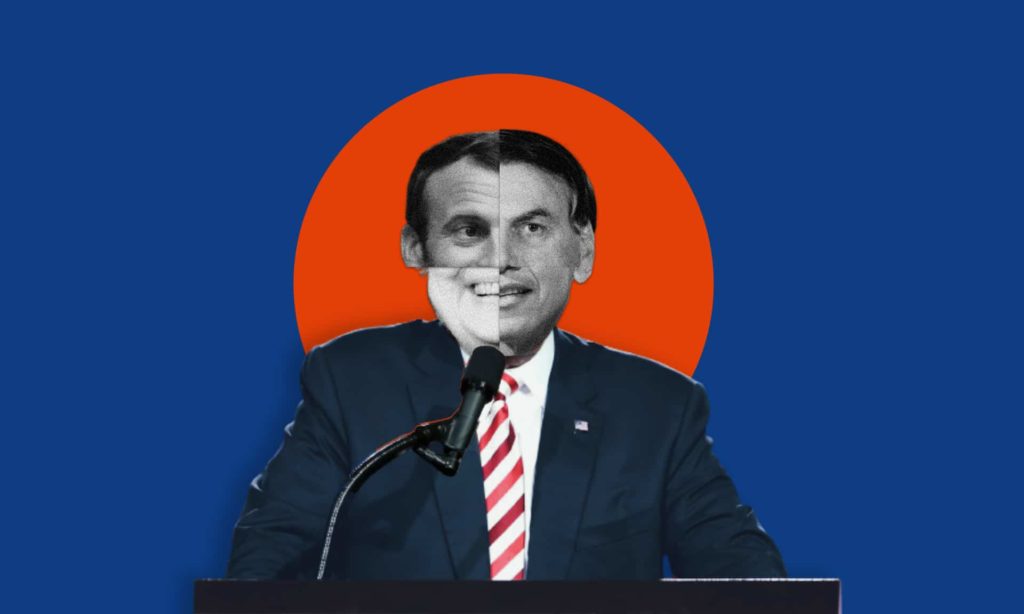
Analyzing political discourse can be tricky, but asking the right questions about a speech can reveal the necessary information to interpret the intentions of the speaker. Photo the UN-aligned design team.
Have you ever found yourself agreeing with a politician for no apparent reason? Have you ever thought why many people support a certain politician even though they hold a ‘foolish’ standpoint? Have you ever thought of how language influences people’s decisions in a political environment?
While it is true that humans are complex creatures and clear linear relationships rarely apply in the real world, language usage and perception undoubtedly plays a significant role in the world of politics, especially today where social factors such as gender and ethnicity are gaining more attention.
In this brief article, I will look at the use of language in political discourse. More specifically, we will also look at the phenomenon known as code-switching, how and why it occurs and some of the effects it bears.
Political discourse
The usage of language that we will analyze today takes place in an environment known as political discourse. Political discourse refers to the use of language by politicians or political entities and affects both the speaker and listener. The analysis of political discourse generally falls under political linguistics. In simple terms, political linguistics is concerned with how politicians use language to reach their political goals.
A politician for instance may campaign for (or against) a specific cause, or they may want to convince people to vote for their political party in an election. Thus they may resort to using language as a tool in order to reach their goals. We will look at one such tool below.
Code-switching
In investigating political discourse, we can utilize the analysis of the sociolinguistic phenomenon known as code-switching. Code-switching refers to alternating between two languages (also known as interlingual code-switching), two varieties of the same languages (e.g. dialects of the same language) or even registers of the same language (e.g. formal vs. informal speech).
We may also call it code-switching if the way the speaker uses language at a certain point differs from how they normally speak and we can combine it with language choice (why a certain language is chosen to communicate) to get a better understanding of the intentions of the speaker. Code-switching may be done consciously or unconsciously. Regardless of which form, it is often done to change the perception the listener has of the speaker.
Monica Hiller argues that code-switching should be looked at as part of a range of linguistic practices people use to establish social goals. In political discourse, these social goals are changed to political goals. So let’s look at some examples that concern each of the three code-switching categories mentioned above.
Three forms of code-switching
The first form of code-switching occurs between two completely different languages. Interlingual code-switching commonly occurs in nations with a history of colonisation (such as India and the Philippines) as well as nations that have multiple official languages (such as Canada and Belgium). Monica Heller argues that when power is stable, convention prevails. Applying this logic to multilingualism, it may be that a politician uses an official language (or more commonly used official language) when they don’t feel the need to manipulate the listener in any way.
Let’s look at some examples. It is common for presidents or prime ministers of a country to speak the official language of their country when talking to an international audience, even though they are fully capable of expressing the same thoughts in a language such as English. The choice of language here may serve to separate oneself (or the nation one represents) from others. In some cases it may even be done to elevate the speaker (and the nation they represent).
On the flip side, a representative of a country may choose to speak the language of the nation they are trying to communicate with to bring them on their side. This can be interpreted as decreasing the distance between the speaker and the listener.
As an example, in both 2009 and 2016, Barack Obama sent a message in the form of a video broadcast to the Iranian people informing them of the good will of the United States of America and their will to improve the relationship of the two nations. This was done as an attempt to get the Iranian population on his side. Both speeches are approximately five minutes long and are done in English, however the president ends both speeches with a happy new year message in Farsi.
As with many social sciences, it is relatively difficult to predict how much effect a simple phrase in Farsi had on the Iranian population, but in discourse analysis looking at the intentions of the speaker is often more important than the actual effects.
The second form of code-switching occurs between two varieties of the same language. This type is common where a standard form of language is often reinforced. In the People’s Republic of China, there exist more than 100 dialects of the same language depending on the way we differentiate between languages, dialects and accents. It is common for officials in China to speak in Mandarin Chinese in political meetings, even though it differs from their mother dialect. While language policy also plays a role in this case, the choice often belongs to the speaker. The use of Mandarin Chinese in this case serves as a way to signify unity amongst the entire nation.
The final form of code-switching is among registers of the same language. In sociolinguistics, a register is a variety of language which is used in a particular situation or for a particular purpose. The most commonly known and analyzed registers are formal and informal speech. You may for instance talk more formally when talking to your teacher than when you talk to your siblings (particular situation). You may also be more polite when you want to make a request such as asking your parents for money (particular purpose).
Now that we have a basic idea about language choice and code-switching, we can try to analyze how politicians talk.
When we hear a politician talk, we should ask the following questions to see if any linguistic manipulation is taking place
- What language is the speaker using to communicate with the audience and does code-switching occur?
- How does the code-switching occur (from what variety/language to what variety/language)?
- Is this a conscious decision / does the speaker have a specific goal in mind?
- What are the goals of the speaker?
- How does the speaker intend to affect the listener?
Analyzing political discourse, like analyzing any other discours, can be tricky and needs to be handled with care, however the answers to these questions often reveal the necessary information to interpret the intentions of the speaker.
Two thought experiments
Now let’s look at two scenarios one hypothetical and one from the real world.
-Thought experiment one: The language choice of a populist
Let’s ponder upon the following question: “What kind of language would a populist want to use?” The politician may make a conscious choice to code-switch from formal speech to informal speech. The populist ideology presents “the people” as a morally good force and contrasts them against “the elite”.
As we have discussed earlier, the use of formal language often creates a distance between the speaker and the listener, thus it may come across as elitist which goes against the goals of populism. The use of informal language on the other hand closes this distance and makes the politician more relatable, and thus often appealing to the “voice of people”. The politician may also consciously make the decision to code-switch to a second language. This may be done in order to appeal to the local or ethnic population.
-Thought experiment two: the election of Donald Trump
Now we may turn to a real life example of how the choice of language influenced people’s choice of presidential voting. Let’s look at the 2016 U.S. elections where Donald Trump came out victorious even though most people initially counted him out. Without a doubt, various factors played a role in the 2016 U.S elections, but let’s turn to the (potential) effect of language choice and code-switching. Firstly, Trump made use of a very informal register of the English language which reduces the distance between him and the listeners.
Secondly his speeches are often unscripted (or at least become unscripted at some point) and he appears to believe everything he says which makes him appear genuine and honest. Many people interpret him as being the voice of the people. Of course we can also look at language specific properties for English such as sentence structure, word usage, etc. The insight provided by George Lakoff in a Vox article goes into more detail about these specific properties.
Final words
There are various factors that affect our decisions and language plays an undisputable role in it. The same is true for political discourse. Politicians often have very large audiences and thus massive social influence. Therefore, it is crucial that we stay aware of the implications of what kind of language they use. The branch of linguistics known as political linguistics can be of help here. Political linguistics needs to utilize tools from various fields such as discourse analysis, sociolinguistics and cognitive linguistics to answer questions regarding how politicians use language.
In this brief article, we talked about language choice and code-switching, its types and why it occurs and we looked at some hypothetical and real-life examples. Hopefully, this brief article will make you more aware of what language (or variation of language) politicians use and assist you in making decisions that are guided by logic rather than feeling.
The Perfected Thought: Michelangelo Buonarroti
By Carla Pietrobattista
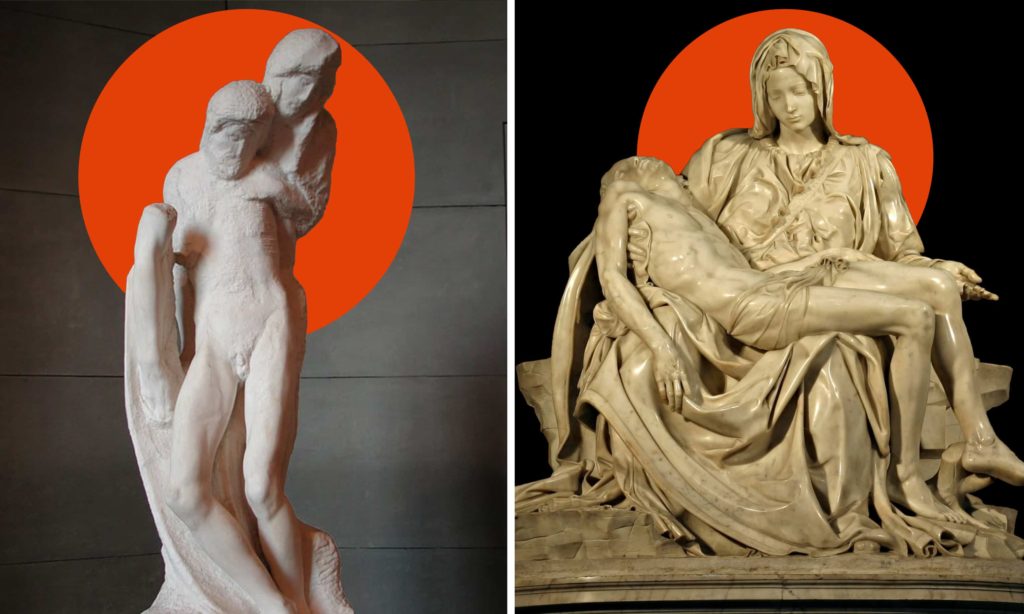
Michelangelo was the creator of the Vatican Pieta & the Rondanini Pieta.
The search for perfection, albeit in different ways and forms, has always accompanied man throughout his growth and impacted his socio-historical imprint . Starting from ideas for the improvement and evolution of the most basic aspects of life, such as the perfecting of agricultural or construction techniques, his ambition stretched to the creation of increasingly perfect buildings and works of art. Although there is no universal concept of absolute perfection, because every judgment or perception of beauty is inevitably conditioned by its own yardstick, I find that everyone in art, in any form of art, can find or express their own idea of perfection.
Confronting opposing Pietas
Starting from this duality between conception and perception, I would like to make a rather daring attempt, that is to approach the examination of one of the greatest artists in the history of Italian art: Michelangelo Buonarroti (Caprese 6 March 1475 - Rome February 18 1564).
The evolution of his artistic path is a perfect example of how one can reach formal perfection, and then go beyond it, and perhaps deny it, through the expression of the most intimate perception of perfection and beauty. Recognizing my limitations, I am fully aware that by choosing this topic and applying it to an artist who was, as Vasari also testifies, able to move and express himself in almost all the arts, I am exposing myself to the same risks and ruinous consequences of the flight of Icarus, who fell for daring to fly too close to the sun.
However my personal emotions, linked to the observation, study and comparison between two of Michelangelo’s Pietas (at least three Pietas were certainly made by him) are so strong that they push me to write and share my considerations, accepting all the risks involved.
The Vatican Pieta
Michelangelo lived in a highly stimulating and dynamic historical moment for Italian artists, a time during which they could really live on art and thanks to art, because financed by gentlemen who, in addition to loving to surround themselves with beauty, acquired prestige both from the exhibition of the works of art financed by them and from the signature of the material performer of the work itself. Although these patrons were very often cumbersome and limiting with regards to the free expression of the artist, just as often they proved to be decisive for the creation and birth of authentic masterpieces.
Even the first Pieta that I will examine, namely the Vatican one, was born thanks to the request of a client: Cardinal Jean de Bilhères de Lagraulas, who commissioned Michelangelo to create a sculpture depicting “A dressed Virgin Mary, with a dead Christ in her arms, as big as a righteous man is “.
We know that the artist began the sculpture in 1497 and completed it in 1499, after having personally chosen the block of white marble from Carrara, to be worked with the art of “removing”. It is important, if not fundamental, to pay particular attention to the dates, considering the year of the artist’s birth and the date of the realization of this work (known to us thanks to the contract stipulated between the cardinal and the artist) that Michelangelo executed the Pieta when he was just in his early twenties. He therefore did not get the job because he was already known to most people, rather he accepted it precisely in order to make himself known.

Michelangelo’s Pietà, St Peter’s Basilica (1498–99)
The artist managed to have the cardinal’s trust thanks to the banker Jacopo Galli, for whom he had created a marble sculpture of Bacchus, whose characteristic perfection prompted the banker to introduce Michelangelo to Rome. There, he was contractually commissioned to create the Pieta sculpture which was to be placed in the chapel of Santa Petronilla, probably to be used as a sepulchral monument for the cardinal.
Michelangelo sculpted this work knowing full well that it would be for him much more than a simple funeral monument, but an opportunity to make himself known both in Rome and in other Italian courts. He therefore made the most of his technical knowledge acquired in the years of Florentine training, first at the Ghirlandaio workshop and then perfected at the Giardino di San Marco.
It is in this Medici garden that young emerging and deserving artists were hosted, by the will of Lorenzo the Magnificent, in a stimulating environment, suitable for the study of the artistic techniques of the past. Thanks to the direct observation of the collection of ancient art belonging to the Medici family, young people could acquire the means and skills to reproduce the perfect characteristics of the works of the classical period. In this garden / gym of talents, not only did Michelangelo’s technical training take place, but also a more intimate and philosophical one that saw him approaching Neoplatonic ideals.
The predominance of beauty
These opportunities not only led him to conceive the idea of a truth hidden behind an excess of matter, but also nurtured a search for the sensitive beauty, which he considered a transposition, reflection and testimony of divine beauty transmitted and made visible to man also through art. This concept of beauty clearly shines through in this Vatican Pieta.
The clothed Virgin, just as required by the contract, has a physical structure whose measures give harmony and support the balance of the entire work. Her features do not appear distorted and are barely scathed by her grief for the loss of her son. Even the body of Jesus, helpless and devoid of the dynamic force of living bodies, retains an intact beauty, not diformed by the manner of his death.
Every single muscle of Christ, even if devoid of the spark of life, still seems to retain the memory of that force which until a few hours before was still active and manifest. Typical of a pieta, the Virgin holds her son in her arms and supports him, in a characteristically maternal gesture. Mary’s hands seem to speak to us, giving voice to a hidden and unexpressed thought.
The right hand appears as the hand of the mother who holds and supports her beloved son by drawing him to her as if to keep him close, while the left hand seems to offer the sacrifice of her son, despite her suffering, knowing full well that now more than ever, he is no longer hers alone. In so doing, her status as mother of the Church is highlighted.
The features of the Virgin and the child share the same perfect beauty that makes them seem peers and not mother and son. This detail is not an oversight, or a forcing of Neoplatonic thought, but rather a different way of reading the theme of the pieta, which is not only the representation of a mother holding up her dead child, but that of a mother who already from the moment of the annunciation and the birth of the child knew what fate was reserved for them.
Once the sculpture was finished, the Pietà was positioned as planned inside the chapel of Santa Petronilla, only around 1517 was it transferred to St. Peter’s Basilica in the Vatican. The marble group immediately achieved enormous success. The evident beauty and stylistic perfection of the work, however, left many observers doubting its provenance, leading them to imagine that it was the creation of a mature hand. It is said that Michelangelo, listening to two men praising his statue, but attributing it to another sculptor, decided to put his signature on the band that holds the Virgin’s shoulder strap, indicating not only his identity, but also his city of origin and training : Florence.
Before examining the other Pieta and to highlight the perfect beauty of the Vatican statue, I quote Vasari’s comment on this first Pieta by Michelangelo, fifty years after its realization:
"Do not ever think, oh sculptor or rare craftsman, to be able to add design, grace, or effort, nor to be able to refine, purify or pierce the marble, as deftly as Michelagnolo did in with his art, because one can see in it all the value and power of art is".
The Rondanini Pieta
In examining the other Pieta, the Rondanini one (so called because it was purchased by the Rondanini family in 1744), I will start again from the dates of its creation that place it between 1552 and 1564. It is said that Michelangelo worked on it, without ever finishing it, until a few days before his death, in a period of his life in which the artist no longer sculpted under commission, but exclusively for personal impulse.
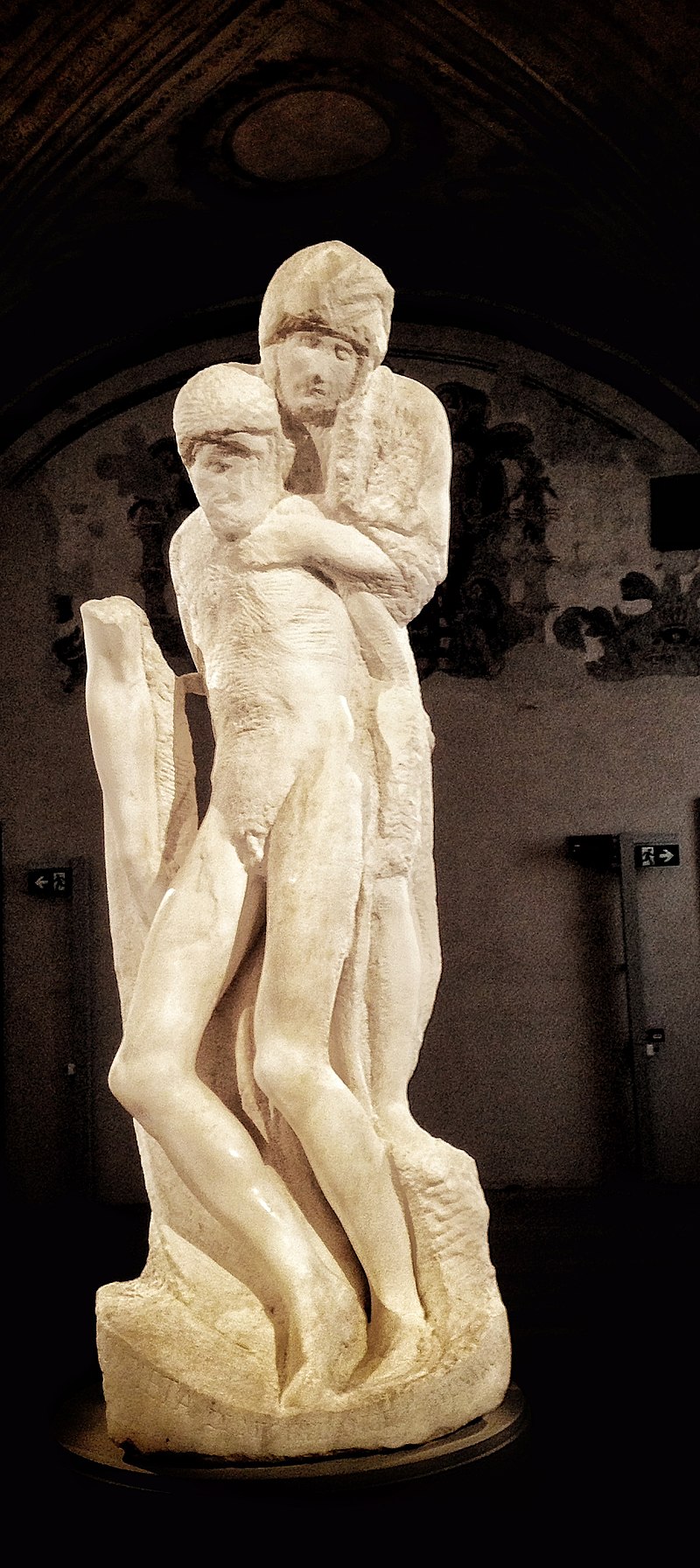
Pietà Rondanini Michelangelo Buonarroti. Photo by Opera propria
Probably the master worked on it while contemplating the decoration for his own burial monument. If we consider the dates of realization of the two Pietas, limiting ourselves to observing what we see without any introspective examination, we would certainly be misled because in most artistic studies, the critical examination of the works leads one to divide the different creative phases of the artists into a timeline that almost always coincides with a line of evolution and improvement of technique.
Following this methodology of study and approach, thus leaving out the most intimate and conceptual considerations, we should imagine the two Pietas with inverted dates. Therefore, the Rondanini Pieta would come first and the Vatican one, last. The stylistic differences with respect to the Vatican Pieta are enormous both in the “structural” setting of the work and in the type of technical workmanship.
The composition of the characters in the Rondanini Pieta is opposite to that of the first, because it has a vertical development where Jesus and Mary are reproduced in a pose that does not allow for the meticulous attentions of Vatican sculpture. In the Vatican Pieta, not only the two bodies, but also the folds of Maria’s dress had been designed and studied to create a perfect balance in the overall look of the work.
The idea of a vertical development of a pieta was a great novelty in the artistic field. This originality and desire to dare and experiment, is also usually made to coincide with the artistic approach of the young artist who needs to be noticed and known. In our case, Michelangelo had already known the fame and glory. He had achieved them thanks to his respect for all the technical and philosophical rules acquired in the years of his youth.
At the time of the realization of the Rondanini Pieta, the artist, now elderly, felt free from the needs of personal affirmation of the early days of his career, moreover, having no client constraints, he could express himself in a freedom that I would define as an expression of thought and form, aware of being able to make visible one’s own concept of a pieta.
The predominance of truth
The Virgin in the Rondanini sculpture is standing and not sitting as in Vatican Pieta, she embraces and supports the dead son whose legs, bent towards the left of the observer, are the only true support and balancing point of the entire work. The faces, although not perfectly defined and finished, express a feeling of pain and profound resignation.
Every single stroke of the chisel gives the idea of the unfinished, nothing has been smoothed and worked in the manner of Vatican Pieta, but I believe this has nothing to do with the unfinished nature of the work. Every crack, every lack of completeness, is certainly the result of the precise will of Michelangelo, who in this embrace, so different from the first he made, transmitted his thoughts on pain and death.
Not only the death of Jesus, which Michelangelo as a believer knew how to express, but also of his own death that he now felt ever closer. This awareness and much of the conceptuality behind the work, I find can be read and deciphered thanks to the aforementioned vertical development of the structure, which with a height of 195 cm allows for different interpretations. Observing the piety from top to bottom, it is possible to see a mother holding her dead son in a last strong embrace before laying him on the ground.
Looking instead at the work from a different perspective, from bottom to top, we see Mary supporting her son in anticipation of the imminent resurrection. Both interpretations appear entirely plausible, but perhaps the most profound and true reading is the one that is offered through frontal observation, which presents the body of Mary and her son merged in a last embrace equal to the first, that is, as that of the moment of the conception of Jesus. Mary then almost seems ready to welcome her son back into her body.
I do not know if all these considerations are correct, for this reason I do not know if it is right to share them, but I believe that art is nothing more than a means, a vehicle, to give voice to emotions, not only those of the artist, but also those of the observer.
For me it was a revelation to feel, through the examination and comparison of these two works, that artistic maturity does not always coincide with the perfection of style and expression, but rather with the achievement of the awareness of will and power express what is believed to be one’s own perfect thought, achieved by scratching and crumbling one’s knowledge, one’s certainties, to reduce them to a minimum in order to find the truth, or at least one’s own truth.
The perfect beauty of the first Pieta could no longer correspond to the dawning personal anticipation of Michelangelo’s own death, who by now was old and who no longer had the urge to capture beauty as much as truth. It is in the truth that pain, or even only the idea of pain and death, appears for what it is and above all makes us appear for what we are, revealing our essence without any conceptual superstructure.
The Torlonia Marbles - in Pictures
By Adrian Liberto
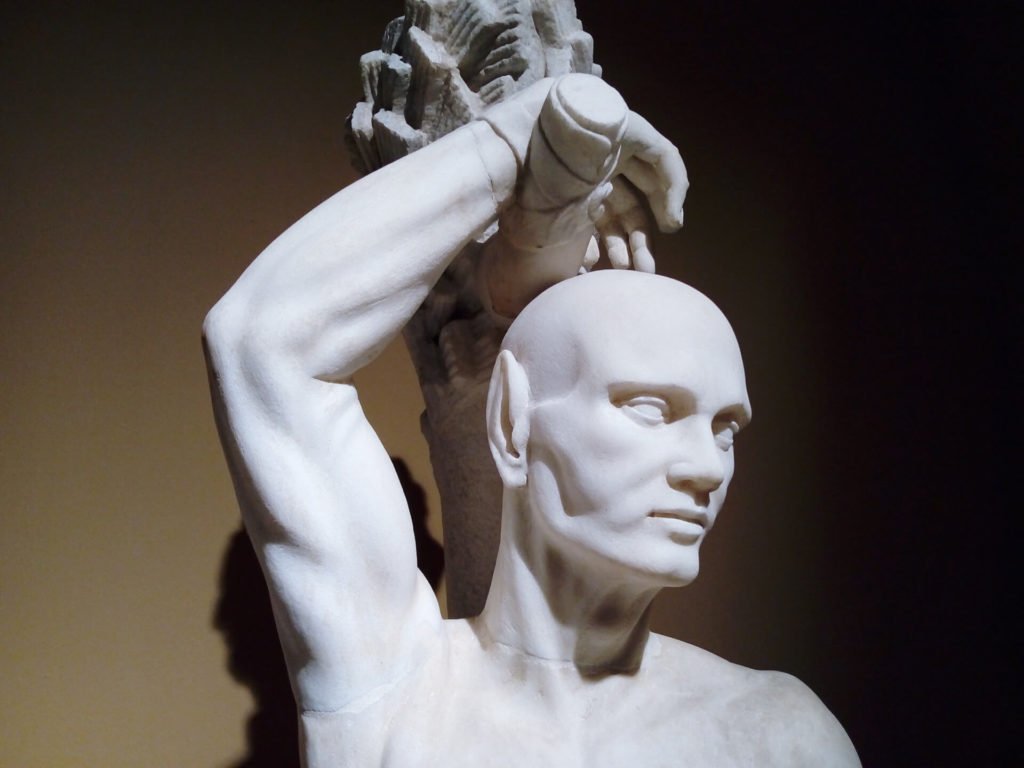
One of the fragments making up the body of Hercules
This gallery is from the exhibition of the Torlonia Marbles, the largest collection of classical sculpture still in private ownership and one of the most valuable in the world.
The Gordian Quiz: Birds with Facetious Names, UFOs, UN Secretariats & more…
News in June 2021 you may have missed
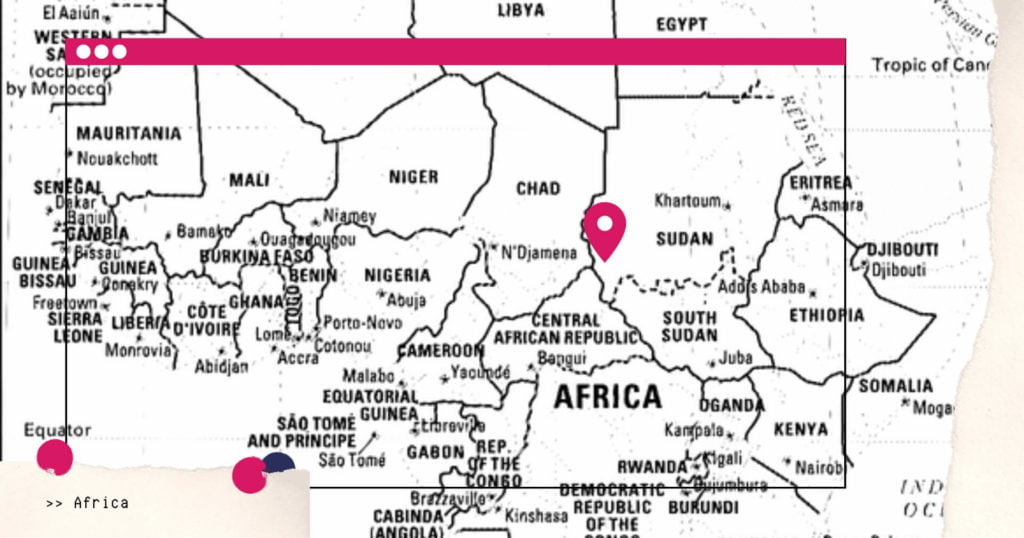
AFRICA
02.06.21: Mali. The African Union has suspended Mali from the African Union over its second coup in nine months.
05.06.21: Burkina Faso. At least 160 villagers were slaughtered in a brutal onslaught that ended with the village being set on fire. Islamic militants are the likely perpetrators of the attack, though no group has as yet claimed responsibility for it.
12.06.21: Nigeria. Another senseless killing spree has left 53 people dead in the north of the country. The assailants hunted people down as they fled for their lives in a number of villages in northwest Nigeria’s Zamfara state.
15.06.21: Algeria. The National Liberation Front (FLN), which has been in power for nearly 20 years, has won the most seats in the parliamentary election held on June 12. The party fell short of an overall majority, gaining only 105 seats in the 407-seat parliament.
17.06.21: Ivory Coast. Former president Laurent Gbagbo, who had been living in Belgium for the last three years after his acquittal for crimes against humanity by the ICC, returned to his country after a ten-year absence amidst protests for and against his return. Gbagbo had tried to usurp power despite having lost his presidency in the 2010 elections. This resulted in riots and the loss of thousands of lives, which led to his arrest and extradition to the Hague in 2011 where the trial took place.
22.06.21: Ethiopia. Scores of shoppers were killed when airstrikes targeted a busy market town in the Tigray village of Togoga. Evidence suggests that the Ethiopian Air Force was responsible.
25.06.21: Madagascar. The UN has called for aid as the southern part of the country is facing starvation following extended periods of drought. Over a million people are in urgent need of supplies according to the World Food Programme.
30.06.21: South Africa. Former President Jacob Zuma, who was forced to resign in 2018 following a corruption scandal has been sentenced to 15 months in prison after failing to appear in court as part of the inquiry.
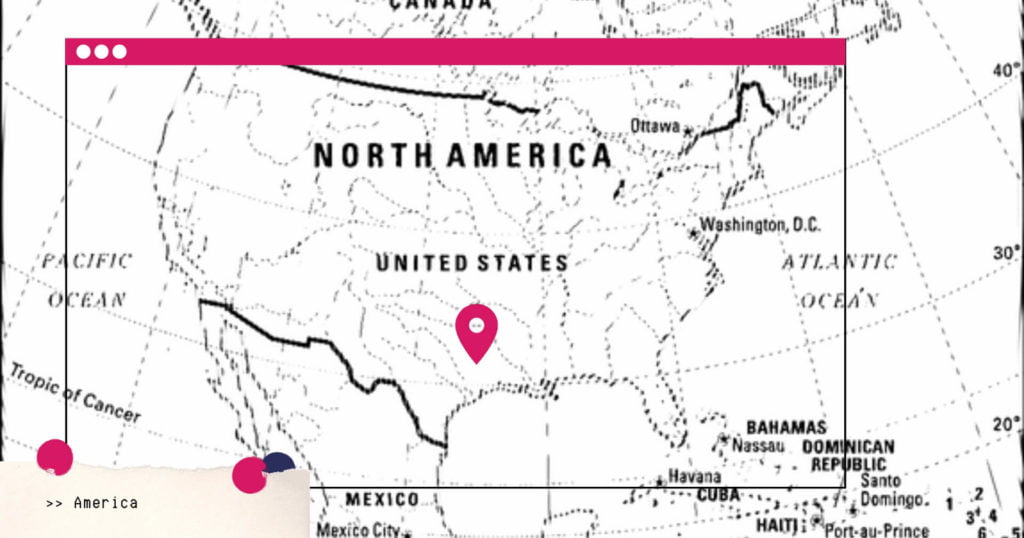
THE AMERICAS
02.06.21: Nicaragua. The home of opposition leader Cristiana Chamorro was stormed by police in what appears to be intimidation tactics by leftist President Daniel Ortega who is hoping to be re-elected later this year.
04.06.21. USA: Facebook Inc. announced that former President Donald Trump would remain suspended from the platform until at least January 2023.
05.06.21: Mexico. The build up to the midterm elections this weekend has resulted in the assassination of about 90 politicians across the country, 35 of whom were actual candidates.
05.06.21: Guyana. President Mohamed Irfaan Ali declared that the country is facing the worst natural disaster in its history in the wake of floods that are devastating vast areas, including tens of thousands of farms.
09.06.21: El Salvador. A woman who miscarried when she tripped while eight months pregnant was released from jail after having spent 10 years of a 30-year sentence for abortion. Meanwhile, the country becomes the first to adopt Bitcoin as legal tender.
15.06.21: Peru. Despite the completion of the electoral vote count and the leftist Pedro Castillo winning a majority with 50.125% votes, a winner has not yet been declared following the presidential election. His rival was right-wing Keiko Fujimori, the daughter of former president Alberto Fujimori, who is currently serving a 25-year sentence for several crimes, including murder, kidnapping and corruption.
22.06.21: Mexico. President Andrés Manuel López Obrador has pledged to investigate a border shooting relating to criminal gangs that left 19 people dead, 15 of whom were innocent civilians.
24.06.21: USA. Scores of people are feared dead after an apartment building collapsed in the southern Florida town of Surfside.
25.06.21: USA. Ex-police officer Derek Chauvin has been sentenced to 22 and a half years for murdering African-American George Floyd in Minneapolis in May 2020.
30.06.21: Canada. A climate change related heat wave has led to over 200 deaths in British Columbia and is affecting millions of people. Fears are growing around the country that the intense heat will also trigger devastating wildfires.
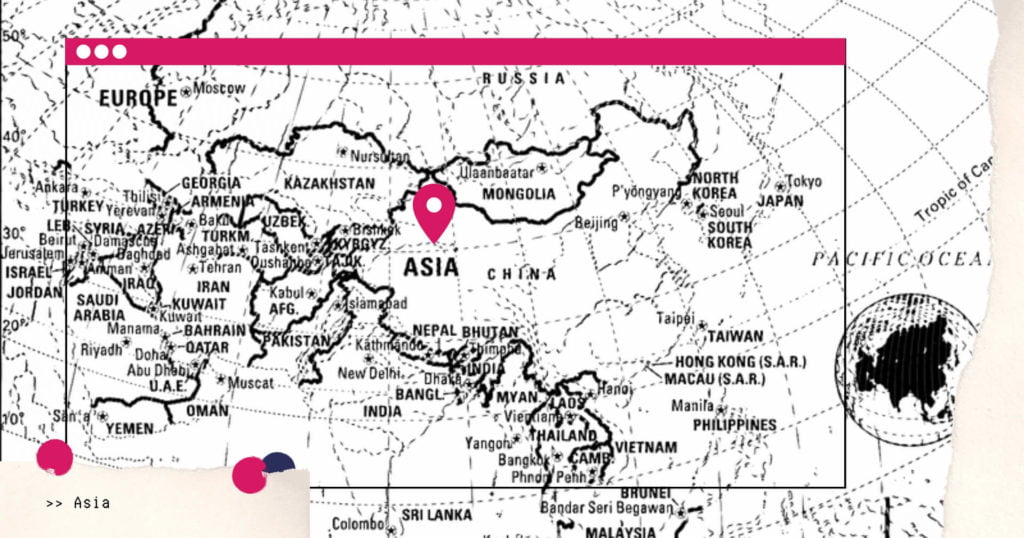
ASIA
02.06.21: Israel. The political opponents of Benjamin Netanyahu from the left and right of the political spectrum have informed the President within minutes of the set deadline, that they have managed to agree a coalition government. Yair Lapis of the centrist Yesh Atid party and Naftali Bennett of the New Right Yamina party will alternate as Prime Minister.
02.06.21: Sri Lanka. Attempts to drag a blazing container ship carrying dangerous chemicals to deeper waters has failed. The cause of the fire, which started two weeks ago, is thought to have been a chemical leak. The accident is already causing catastrophic environmental damage.
13.06.21: India. A 76-year-old man named Ziona, whose family consisted of 89 children by 38 wives died in the north-eastern State of Mizoram. The patriarch belonged to a Christian sect founded by his father, which promotes polygamy.
13.06.21: Israel. After over a decade of a political system led by Benjamin Netanyahu, right-wing Naftali Bennett has been sworn in as the new Prime Minister. He was voted in by the Knesset in a 60-59 vote, with one abstention. His coalition, however, will include several parties including four seats for the Palestinian Ra’am Party led by Mansour Abbas. He is due to be replaced as PM by Yair Lapis of the centrist Yesh Atid party after two years.
19.06.21: Iran. Hardliner Ebrahim Raisi, who in the past has supervised mass executions, has won the presidential elections amid an extremely low turnout.
23.06.21: China/Hong Kong. Apple Daily, Hong Kong’s most popular pro-democracy paper, announced that following the freezing of its assets by the Chinese government, it will no longer be able to operate as of the end of the week.

EUROPE
01.06.21: Cyprus. It was more or less business as usual following the final results of the parliamentary elections yesterday which saw the far-right ELAM party and the centrist DIPA party make significant gains. The centre-right DISY still received the most votes (27.77%), followed by the communist-leaning AKEL party. Executive power rests in the hands of President Nicos Anastasiades, who is elected separately.
01.06.21: Denmark. France and Germany are outraged and are “seeking full clarity” after a report revealed that Denmark’s intelligence agencies were collaborating with the United States to spy on senior European officials, including German Chancellor Angela Merkel and French President Emmanuel Macron.
01.06.21: Spain / Western Sahara. Brahim Ghali, the leader of the Algeria-backed Polisario Front, which is fighting Morocco for the establishment of an independent Western Sahara, appeared before a Spanish court to answer allegations of torture and genocide. His secret admittance to Spain earlier, in order to receive treatment for the COVID-19 virus, had angered Morocco.
08.06.21: Bosnia and Herzegovina. Ratko Mladic, the former Bosnian Serb commander largely responsible for the Srebrenica Massacre in 1995 lost his appeal with the special UN tribunal set up to judge the case.
15.06.21: Hungary. Orban’s right-wing majority passed a law banning any LGBT content for minors under 18. The vote was boycotted by the opposition and passed by only one vote against.
23.06.21: Italy. Prime Minister Mario Draghi reaffirmed the country’s secular constitution after the Vatican’s attempt on the 17 June to block a law aimed at protecting LGBT+ community from hate crimes. “Il nostro è uno Stato laico, non è uno Stato confessionale” (Ours is a secular State, not a religious one). The move by the Holy See has cause outrage around the country.
22.06.21: Spain. The government has issued pardons to nine politicians involved in Catalonia’s 2017 independence referendum.
23.06.21: Spain. British-American entrepreneur, John McAfee, famous for the creation of pioneering anti-virus software, has died in a Barcelona prison where he was serving a sentence for tax evasion. The 75-year-old is thought to have died by suicide. He was wanted for questioning in the US and Belize in relation to other crimes he is suspected of having commited, including murder.
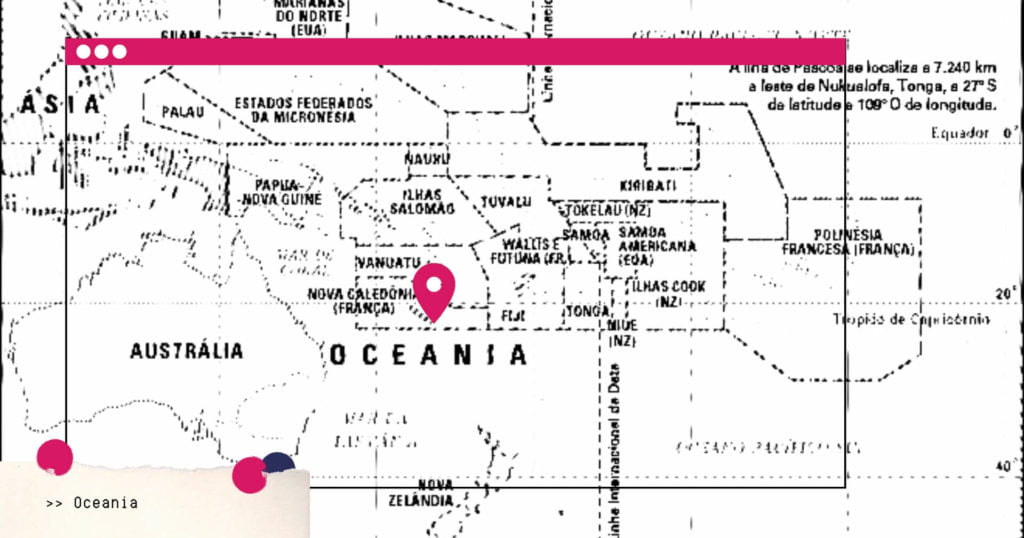
OCEANIA
30.06.21: Australia. The number of cities forced into lockdown with the increase of cases due to the Delta variant of the coronavirus has risen to seven. Alice Springs joined Sydney, Brisbane, Perth, Darwin, Townsville and the Gold Coast.
EU
24.06.21: In the wake of US president Biden’s meeting with Russian President Vladimir Putin, France and Germany’s proposed summit with the Russian leader was rejected after Poland and Baltic countries objected to the suggestion claiming it would send the wrong signals to Moscow.
WORLD
05.06.21: The G7 group of wealthy nations agreed to enforce a minimum 15% tax levy on multinationals who have so far been able to dodge their fiscal responsibilities. The tax will apply in each of the counties they operate in.
08.06.21: Around 800 criminals worldwide, including drug dealers and contract killers, were rounded up in a sting operation orchestrated primarily by Australia and the FBI. The gangs were tricked into using the ANOM app which they believed allowed their communications to be undetected, while the app was in fact developed specifically to ensnare them.

Credits
Editor: Adrian Liberto
Assistant-editor and graphics: Ariana Yekrangi
Writers: Alex Liberto (literary editor), Carla Pietrobattista, Jonna Lappalainen and Aryan Yekrangi.
Read a full list of the photos used in this issue here

